Select a Size
About This Item
usage
sufficient for 15 nuclei preparations (~1-10×107 cells or 1g of tissue per preparation)
Quality Level
packaging
pkg of 1 kit
storage condition
dry at room temperature
application(s)
cell analysis
foreign activity
nuclease and protease, free
shipped in
wet ice
storage temp.
2-8°C
Application
Biochem/physiol Actions
Kit Components Only
- Nuclei PURE Lysis Buffer 180 mL
Signal Word
Danger
Hazard Statements
Precautionary Statements
Hazard Classifications
Aquatic Acute 1 - Aquatic Chronic 2 - Eye Dam. 1 - Skin Irrit. 2
Storage Class Code
10 - Combustible liquids
Flash Point(F)
Not applicable
Flash Point(C)
Not applicable
Choose from one of the most recent versions:
Already Own This Product?
Find documentation for the products that you have recently purchased in the Document Library.
Articles
Centrifugation separates organelles based on size, shape, and density, facilitating subcellular fractionation across various samples.
亚细胞组分离心分离是一种常用技术,广泛适用于多种类型的细胞和组织。由于不同细胞器的大小、形状和密度不同,因此通过离心,可从温和均质的样品中轻松分离和纯化细胞器组分。
Related Content
Instructions
Our team of scientists has experience in all areas of research including Life Science, Material Science, Chemical Synthesis, Chromatography, Analytical and many others.
Contact Technical Service
